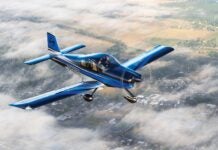
The fifth day started bright and early with the limbering up of the spray gun and the deployment of white – the final major color to go on the jet. John Stahr checked over the masking to make sure it was all correct before shooting three coats of the bright white that ironically will probably be listed as the major color of the airplane when filing a flight plan… “white/red/black”. A short break followed to let the paint set up, then unmasking began – the jet revealed in all its basic glory. We say basic because when the masking was removed, the detailing began.



Details make a John Stahr paint job – little things that mean much to the owner, applied with a fine air brush, and hand mixed colors. While Stahr was laying out the locations of the many detailed elements of the design, two team members began going over the whole airplane with a fine-toothed comb, looking for spots where overspray of one color appeared on another, or where colors bled around rivet heads. They put a small piece of tape near each spot they found that needed touching up, and Stahr will go back with a fine airbrush and a practiced hand to clean them up.



Watching an artist work is magical, because while it is hard to imagine the skill involved, at the same time – he makes it look effortless. But that is years of practice, and decades of experience showing. Stahr’s practiced eye knows exactly how to blend out a blemish or create a gradation in an N-Number. There are a number of safety placards on the jet, and while stickers could have been used, his demand for perfection calls for hand-airbrushed placards which will live under the clear coat which will be the final step in the process.



 Stahr also started creative, free-hand spray-painting, including a few nebulae.
Stahr also started creative, free-hand spray-painting, including a few nebulae.




Air Brushing will continue for at least another day as the final designs are incorporated and flaws fixed before that clear coat – but with Day 5 in the bag, the end is definitely visible on the horizon.
Watch the time-lapse video of the day:














